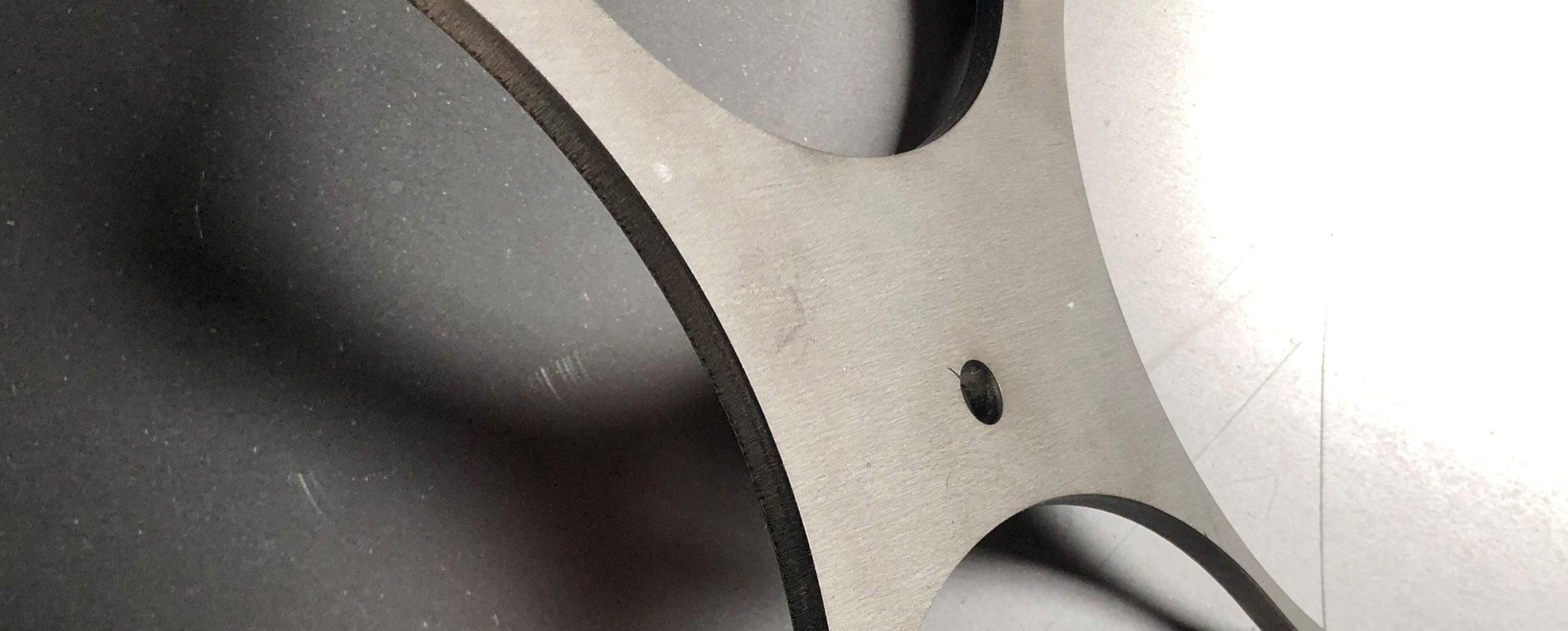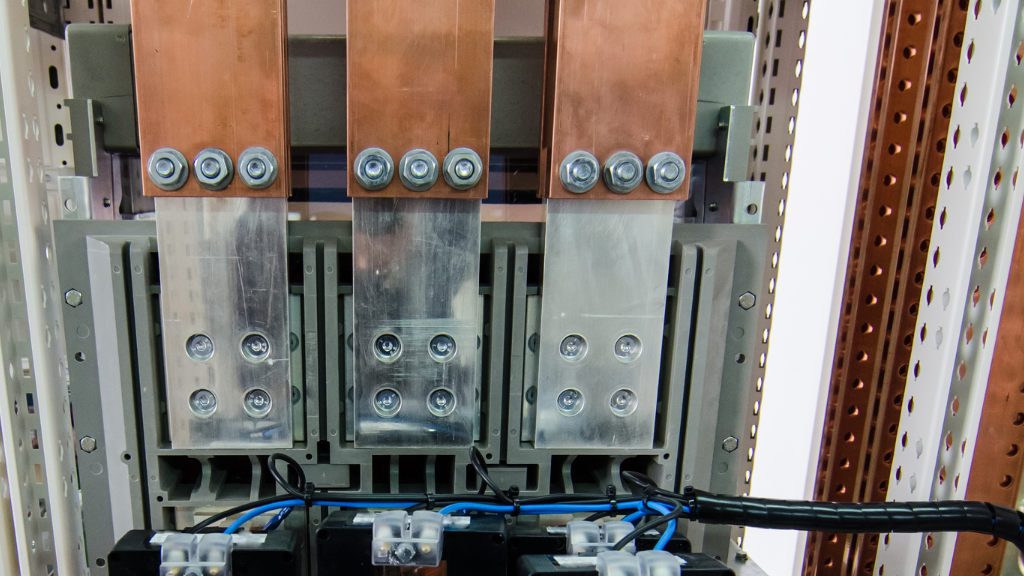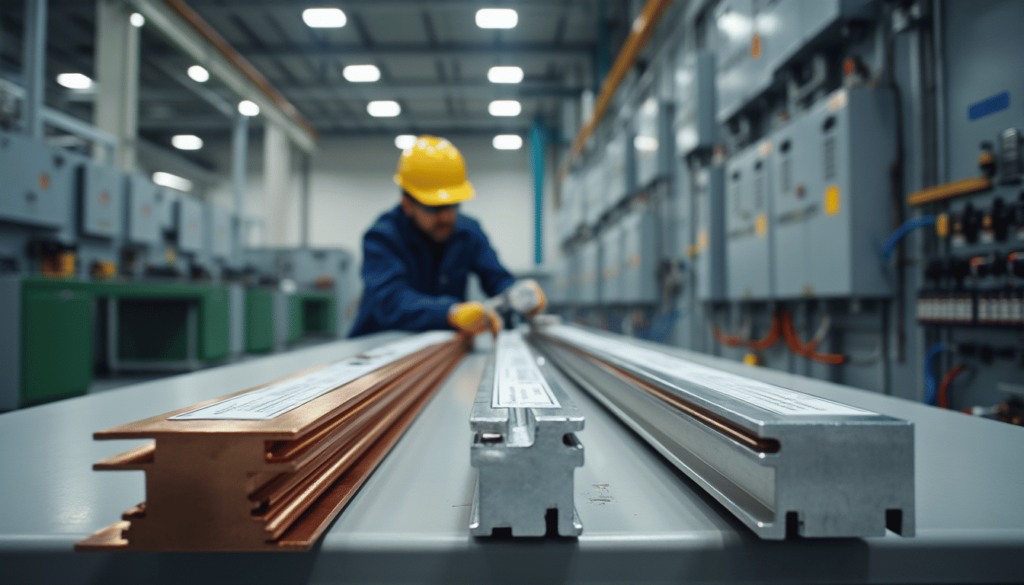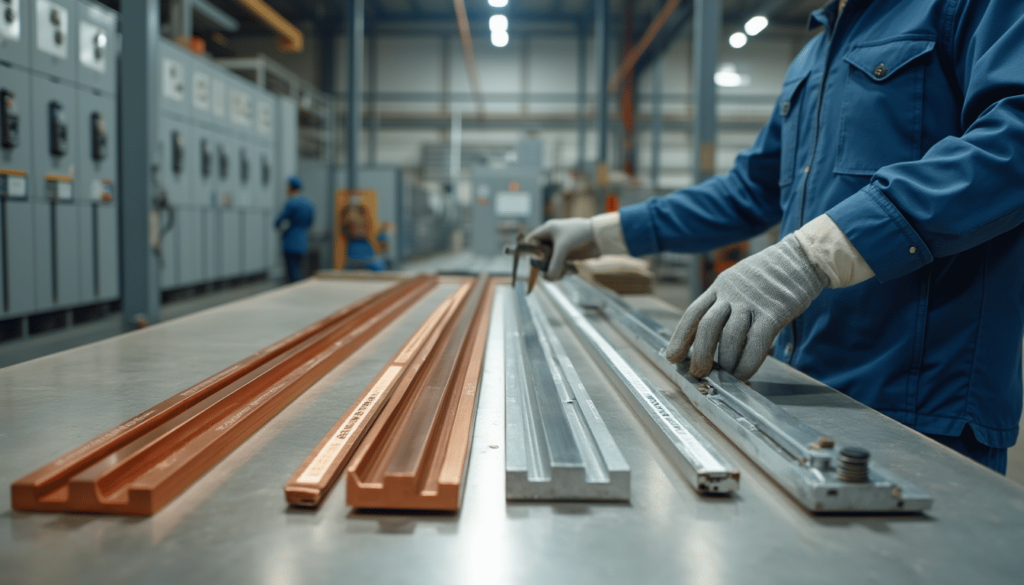Aluminum vs Copper Busbars: Which is Best for Your Electrical System & Busbar Systems?
Choosing the right busbar material is pivotal for optimizing the efficiency and longevity of electrical systems. Aluminum and copper are the primary contenders, each offering distinct advantages that cater to specific applications. Understanding the nuances between these materials can significantly impact system performance, cost, and sustainability. This guide explores the critical differences between aluminum and copper busbars, assessing their conductivity, durability, and maintenance requirements, thus equipping you with the knowledge to make an informed decision tailored to your unique power distribution needs. Dive in to discover which material aligns best with your system’s technical and budgetary demands.
Brief Overview
Choosing the right busbar material, aluminum or copper, is crucial for optimizing the efficiency and longevity of electrical systems. Aluminum offers cost efficiency and lightweight design, making it ideal for large-scale installations. In contrast, copper’s superior conductivity and durability make it the preferred choice for high-demand environments. Each material brings unique advantages, impacting factors like cost, performance, and sustainability. As the industry advances with eco-friendly practices, understanding these differences is key to aligning busbar systems with specific technical and economic goals, ensuring reliability and effectiveness in power distribution.
Key Highlights
- Aluminum and copper busbars offer distinct advantages for electrical systems, impacting cost, conductivity, and durability.
- Copper provides superior conductivity and durability, ideal for high-demand environments and ensuring efficient power distribution.
- Aluminum is cost-effective and lightweight, making it suitable for budget-conscious projects with weight constraints.
- Eco-friendly practices and material advancements are enhancing aluminum and copper busbar sustainability.
- Choosing between these materials involves balancing system requirements, budget, and long-term goals for optimal performance.
Introduction to Busbar Systems
Busbar systems are a critical component in modern electrical infrastructures, enabling efficient and reliable power distribution across various applications. As an owner at AP Precision Metals, I understand the importance of choosing the right materials for these systems. This section will explore the vital role busbars play in electrical setups. By delving into their functions, we’ll see how these components streamline electrical wiring processes, support power management, and ensure robust system performance. Stay tuned as we unpack these elements, shedding light on why busbars are indispensable in today’s electrical environments.
The Role of Busbars in Electrical Infrastructure
Busbars serve as the cornerstone of electrical infrastructure, a point that’s often overlooked in discussions surrounding power systems. As an owner deeply involved in the industry, it’s clear that the primary function of busbars lies in their ability to handle electrical currents efficiently, facilitating streamlined power distribution. These components act as a hub in the wiring network, ensuring electricity moves seamlessly from point to point without interruptions. This efficiency is a significant reason why busbars are favored in everything from industrial settings to residential applications.
The design of busbars, which often involves robust metal strips made from materials like aluminum or copper, contributes to their versatility. This structural composition allows them to handle high currents with minimal energy loss, a feature that’s crucial for maintaining stability in extensive systems. Moreover, their compact nature helps reduce space requirements, making them ideal for installations where space constraints are a concern.
In addition to their efficient physical design, busbars also provide superior safety features. They reduce the risk of wiring errors by minimizing complex cabling, a common source of electrical faults. This simplification enhances overall system safety, reducing the potential for electrical fires or equipment failures. Furthermore, busbars boast excellent heat dissipation capabilities, ensuring that temperatures are kept in check even under heavy load conditions.
On the installation side, busbars offer significant time and cost benefits. Their modular nature allows for quick and straightforward application, reducing labor demands which, in turn, lowers installation costs. At a time when efficiency is paramount, these attributes make busbars a highly sought-after solution in maintaining effective power distribution networks.
Whether in renewable energy plants, data centers, or traditional power setups, busbars are integral to optimizing electrical systems. They allow for innovative design choices that improve operational efficiency and scalability. As we move forward, an understanding of the functionality and importance of busbars will continue to drive advancements in electrical system designs, making them an indispensable part of the infrastructure evolution.
Comparing Aluminum and Copper Busbars
In the realm of electrical systems, material selection is pivotal, particularly when deciding between aluminum and copper busbars. Each offers unique attributes, influencing factors such as conductivity and durability. Selecting the suitable material is crucial for both performance optimization and cost efficiency. This section delves into these materials, comparing their core properties and how they impact busbar performance. We’ll explore how aluminum and copper differ in conductivity and material characteristics, aiding in informed decision-making for system optimization and reliability. Whether aiming for cost efficiency or durability, understanding these nuances becomes crucial for effective power management. As electrical systems evolve with emerging technologies, both aluminum and copper have their roles, and knowing when to use each one can directly impact system performance and longevity.
Material Properties and Conductivity
The choice between aluminum busbars and copper busbars hinges primarily on their material properties and respective conductivity levels. Copper is renowned for its superior conductivity, which often makes it the preferred choice for applications where maximizing electrical performance is crucial. This high conductivity means that copper busbars can transport electricity more efficiently, reducing energy loss and maintaining power integrity. Moreover, it’s not just about conductivity; copper’s robust nature also ensures minimal wear over time, making it a durable option for high-stress environments. This inherent strength allows copper busbars to maintain a stable connection, even under fluctuating load conditions common in industrial settings. Its resistance to high temperatures adds to its durability, meaning copper can handle more stressful operational scenarios without degradation.
On the flip side, aluminum stands out due to its lighter weight and cost-effectiveness. While its conductivity is slightly lower than copper’s, advances in technology and design have allowed aluminum busbars to efficiently meet the demands of many modern electrical systems. It’s important to note that aluminum’s lightweight nature significantly reduces the overall weight of busbar systems, which can be an advantageous feature in large installations where structural support is limited. Additionally, aluminum is more pliable than copper, which can make it easier to work with during installation, allowing for faster modifications and reconfigurations, if necessary.
Advantages of Aluminum Busbars
When selecting materials for busbar systems, the choice often boils down to weighing the pros and cons of aluminum and copper. Each material presents distinct advantages that cater to various needs. This section highlights the advantages of aluminum busbars, focusing on their cost efficiency and lightweight design. We’ll also explore how these benefits impact the overall effectiveness and installation of electrical systems, providing a clear picture of why aluminum might be the right choice for certain applications.
Cost Efficiency and Lightweight Design
Aluminum busbars are highly regarded for their cost efficiency, which is a critical factor in large-scale electrical installations. The price of aluminum is significantly lower than that of copper, making it a more affordable choice for many projects. This cost advantage extends from the raw material expenses to the overall project budget, offering economic benefits that are hard to overlook. A lower upfront cost without compromising on essential functionality makes aluminum busbars an attractive option, especially when budgets are tight or when scaling is a consideration. Furthermore, the lightweight nature of aluminum adds another layer of practicality and efficiency to its use in busbar applications.
One standout feature of aluminum busbars is their lightweight design, which reduces overall system weight. This aspect is particularly advantageous in installations where structural support might be a constraint. The reduced weight eases the transport and handling of these busbars, leading to lower labor costs and simplified installation processes. Moreover, the lighter profile of aluminum busbars minimizes the load on supporting structures, which can extend the lifespan of the entire installation setup. This can be crucial in industries where constant upgrades or reconfigurations of electrical systems are required, as it allows for quicker and more flexible adjustments with minimal strain on system components.
Despite aluminum’s lower conductivity compared to copper, technological innovations and design improvements have enabled aluminum busbars to fulfill many critical requirements efficiently. These enhancements have led to optimized surface area utilization, allowing aluminum busbars to dissipate heat effectively and handle electrical currents with increased reliability. By maximizing surface area, aluminum busbars manage to overcome their inherent conductivity limitations, providing a balance between effective power distribution and material cost benefits. This makes them a suitable choice for many applications, especially when moderate conductivity suffices, and when there’s a necessity to prioritize cost and structural advantages.
The decision to use aluminum busbars is not made lightly—it stems from careful consideration of the operational demands and financial constraints of specific projects. By weighing their cost efficiency against the system’s electrical performance needs, project managers and engineers can ensure that they select a material that aligns with both budgetary goals and functional requirements. Aluminum’s cost and weight advantages make it a desirable option for projects aiming for economic scalability without compromising on reliability or safety. In conclusion, the innovative use of aluminum in busbar applications underscores the material’s potential for adaptability and cost-efficiency in various electrical systems.
Benefits of Copper Busbars
In electrical systems, the choice of busbar material significantly impacts the system’s efficiency and reliability. Copper busbars are renowned for their superior performance, mainly due to excellent conductivity and durability. As the owner of AP Precision Metals, I’ve witnessed firsthand how these qualities enhance electrical systems’ capabilities. In this section, we’ll explore the benefits of copper busbars, focusing on their durability and unmatched conductive performance, providing insights into why they often outperform other materials like aluminum in demanding electrical environments.
6 Ways Copper Busbars Improve Electrical Efficiency
- Reduced Electrical Resistance
- High Current Carrying Capacity
- Improved Thermal Management
- Compact Design for Space Efficiency
- Enhanced Safety and Reliability
- Easy Maintenance and Long Lifespan
Durability and Conductive Performance
Copper busbars stand out in electrical systems for their unparalleled durability and superior conductive performance. Copper naturally offers excellent electrical conductivity, a crucial factor when ensuring efficient power distribution within high-demand systems. This high conductivity ensures that copper busbars can carry electrical currents with minimal resistance, reducing energy losses that can be detrimental to system efficiency. As a result, systems utilizing copper busbars tend to experience smoother operation, lower energy costs, and improved overall performance. This characteristic makes copper the material of choice for applications where power integrity and reliability are paramount.
Moreover, the durability of copper is another compelling advantage. Copper’s robust nature enables it to withstand significant wear and tear over time, maintaining performance under stress. This is particularly relevant in environments where fluctuating loads and high temperatures are expected. Copper doesn’t easily deform or corrode, even under harsh conditions, ensuring longevity and reducing the need for frequent replacements. This durability translates into lower maintenance costs and increased system uptime, which are critical factors in extensive industrial operations.
The choice of copper busbars also supports superior thermal performance. Copper’s excellent thermal conductivity allows it to dissipate heat effectively, even under high electrical load conditions. This heat dissipation capability helps maintain optimal temperatures within the system, improving safety by reducing the risk of overheating and subsequent failures. Consequently, copper busbars are often the go-to solution for high-power applications, including data centers and power distribution networks, where heat management is a top priority.
Furthermore, the structural integrity of copper contributes to stable connections within complicated electrical systems. Its resistance to deformation under load helps maintain strong, reliable connections, minimizing the risk of electrical faults. This feature is particularly advantageous in critical infrastructure settings where reliability cannot be compromised. Choosing copper busbars translates into choosing a more stable, efficient, and longer-lasting solution for your electrical needs.
From an owner’s perspective at AP Precision Metals, the investment in copper busbars is one that reliably pays off in performance and durability. When considering upgrades or new installations, the superior conductive properties coupled with long-term durability make copper an invaluable asset in ensuring your electrical systems operate at peak performance without unnecessary interruptions. Investing in copper busbars means investing in reliability, efficiency, and the peace of mind that comes with a robust electrical system.
Applications in Electrical Systems
Busbars are instrumental in modern electrical systems due to their efficiency and versatility. This section examines how these systems operate in various applications, focusing on the selection of materials that best fit specific electrical requirements. We’ll delve into how location and specific system demands influence the choice between aluminum and copper busbars, providing insights into optimizing the busbar system for enhanced performance. Understanding these applications helps ensure that the electrical setup meets both operational and economic goals.
Choosing the Right Material for Your Needs
In the realm of electrical systems, selecting the right busbar material is crucial for ensuring optimal performance and efficiency. As a trusted provider in the industry, AP Precision Metals recognizes that the choice between aluminum and copper can significantly impact the functionality and cost-effectiveness of electrical systems. When evaluating the choice of material, several factors, such as the location, the electrical demands, and the specific requirements of the busbar system, should be considered to make an informed decision.
The importance of location cannot be understated when choosing aluminum or copper for the busbar system. Environmental factors such as temperature fluctuations, humidity, and exposure to corrosive elements affect the long-term performance of the busbars. Copper’s resistance to corrosion and its durable nature make it suitable for environments with high temperatures or corrosive conditions, such as coastal locations or industrial settings. On the other hand, aluminum’s lighter weight and sufficient conductivity make it a practical choice in settings where structural load limitations are a concern, such as in high-rise buildings or retrofit applications.
Understanding the electrical system’s unique needs is paramount. Copper busbars, with their superior conductivity, are ideal for high-demand systems where reliable performance and energy efficiency are critical. These applications often include data centers, power generation facilities, and industrial plants where any energy loss could result in significant operational costs. Copper’s excellent thermal conductivity also makes it a preferred choice for managing heat dissipation, reducing the risk of overheating and potential system failures. This durability ensures long-lasting performance, minimizing maintenance needs and downtime.
Conversely, aluminum busbars are highly preferred in scenarios where budget and weight considerations are paramount. While aluminum’s conductivity is lower, technological advancements have made it possible to design busbars that maximize surface area, thereby enhancing their heat dissipation capabilities. This innovation allows aluminum to cater to a broader range of applications, including those where moderate conductivity suffices. Moreover, the cost savings with aluminum can be substantial, making it an attractive option for large-scale installations where economic scalability is essential.
From my experience at AP Precision Metals, the choice between aluminum and copper must be approached with a clear understanding of the project’s operational demands, location-specific challenges, and financial constraints. It’s not just a matter of selecting one material over the other; it’s about aligning the system’s needs with the material’s strengths to achieve the best overall outcome. By prioritizing factors like conductivity, durability, cost, and installation, decision-makers can ensure a tailored solution that optimizes the performance and lifespan of the electrical systems. Ultimately, the selection process should focus on meeting both the immediate and future demands of the installation, ensuring long-term reliability and efficiency.
Industry Trends and Innovations
As the landscape of electrical systems continues to evolve, staying abreast of the latest industry trends and innovations becomes essential, particularly when weighing options like aluminum and copper busbars. This section delves into emerging practices and technological advancements within the field. In particular, we focus on how eco-friendly practices and material advancements are shaping the future of busbar applications. We’ll explore the sustainability strides in materials and the innovative methods influencing busbar manufacturing and deployment, offering a comprehensive view of the trajectory this industry is embarking upon.
Eco-Friendly Practices and Material Advancements
In recent years, eco-friendly practices have taken center stage in the manufacture of busbars, significantly influencing the choice between aluminum and copper materials. As the owner of AP Precision Metals, I’ve observed firsthand the shift towards sustainability-driven advancements in the electrical industry. This trend is fueling innovations in both materials and processes used in busbar production, aligning with evolving consumer preferences and regulatory requirements. One of the major forces behind these moves is the pursuit of reducing the environmental impact associated with traditional manufacturing practices.
Aluminum stands out as a particularly viable candidate for eco-friendly advancement due to its recyclability. The recycling process for aluminum requires a fraction of the energy needed to produce new aluminum from raw materials, thereby reducing carbon emissions significantly. This property is appealing from both an environmental and economic standpoint, as it decreases material costs and promotes sustainability in large-scale projects. Furthermore, recent advancements in surface treatment technologies have enhanced aluminum’s efficiency, offering better performance with less material, which indirectly minimizes its environmental footprint.
Copper, on the other hand, is also part of the eco-friendly conversation. Known for its high conductivity, copper busbars are effective in energy conservation—they help minimize energy wastage, which is a critical component of sustainable electricity management. Current innovations are focusing on improving the extraction and production processes for copper to make them less harmful to the environment. Techniques such as improved surface engineering are being employed to extend the lifecycle of copper busbars, reducing the frequency of replacements and, thereby, lowering the environmental cost of material depletion.
The industry’s push for material advancements doesn’t stop at choosing better materials but extends to how these materials are utilized in innovative ways. For instance, the adoption of composite materials combines the strengths of both aluminum and copper, leading to the development of hybrid busbars which offer a balance between high conductivity and low weight. These advancements not only provide technical benefits but also contribute to eco-friendly objectives by reducing resource usage and optimizing material performance in electrical systems.
In conclusion, the shift towards eco-friendly practices and advancements in material science is reshaping the landscape of busbar systems. Both aluminum and copper are pivotal in this change, each offering unique benefits that, when used innovatively, support the broader goal of sustainability. At AP Precision Metals, embracing these advancements means pushing the boundaries of what’s possible, ensuring that the products we deliver not only meet today’s stringent performance standards but also contribute positively to a sustainable future. This dynamic approach secures both environmental and business growth, aligning with a responsibility towards better support of electrical infrastructures around the globe.
Conclusion: Making the Best Choice for Your System
In the journey of choosing between aluminum and copper busbars for your electrical systems, it’s crucial to weigh the advantages and limitations of each material. Both offer distinct benefits that cater to varying needs, but the decision ultimately lies in aligning these benefits with your specific system requirements and goals. In this conclusion, we’ll synthesize the factors influencing your choice, focusing on application needs, economic considerations, and evolving industry trends. By examining these topics in detail, owners can make informed decisions that maximize both performance and cost-efficiency, securing the best outcomes for their busbar systems.
In conclusion, selecting between aluminum and copper busbars involves evaluating factors such as project budget, electrical conductivity requirements, and installation environments. While copper offers superior conductivity and durability, aluminum provides cost savings and lighter weight, making it ideal for certain applications. Ultimately, the choice should align with your project’s specific needs and long-term goals. Consulting with a professional like those at AP Precision Metals can offer tailored advice and solutions, ensuring that you select the most efficient and effective busbar material for your electrical system and busbar applications.
FAQs
Q: What are the main differences between aluminum and copper busbars?
A: The primary differences between aluminum and copper busbars lie in their conductivity, weight, and cost. Copper offers superior electrical conductivity and durability, ideal for high-demand environments. In contrast, aluminum is lighter and more cost-effective, making it suitable for large-scale installations and projects with budget constraints.
Q: How does the choice of busbar material affect system performance and longevity?
A: The choice of busbar material significantly impacts system performance in terms of efficiency, energy loss, and durability. Copper busbars provide excellent conductivity and stability, leading to efficient power distribution and minimal energy waste. Aluminum busbars, while slightly less conductive, offer economic and weight advantages, contributing to ease of installation and potential cost savings.
Q: In what types of environments are aluminum busbars more advantageous?
A: Aluminum busbars are advantageous in environments where weight and cost considerations are critical. Their lighter nature and relative affordability make them suitable for structural load-limited installations, such as high-rise buildings or retrofit applications. Additionally, they are preferred for projects requiring extensive scalability while maintaining cost-effectiveness.
Q: What are the benefits of copper busbars in high-demand systems?
A: Copper busbars excel in high-demand systems due to their high electrical conductivity and robust durability. They ensure efficient power distribution, reduce energy losses, and maintain system integrity even under fluctuating loads and high temperatures. This makes copper busbars ideal for applications like data centers, power generation facilities, and industrial plants.
Q: How are eco-friendly practices influencing busbar material choices?
A: Eco-friendly practices have led to advancements in busbar materials, focusing on sustainability and reduced environmental impact. Aluminum offers significant recyclability benefits, while copper busbars contribute to energy conservation through their high conductivity. The industry is innovating through composite materials and improved production processes to enhance the sustainability of both materials, aligning them with modern environmental standards.



